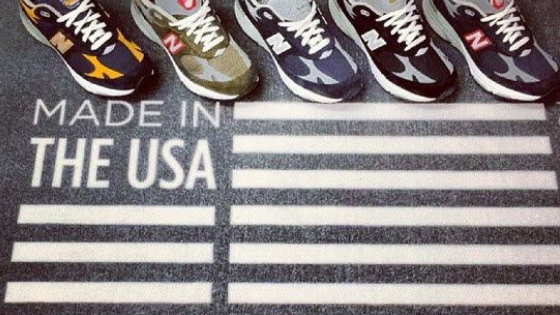Editors note: Good news. An important expansion of buy America programs. We need to expand it even more this year so US taxpayer money is spent on buying made in USA goods.
New recruits at Lackland Air Force Base shuffle into a room stacked high with shoe boxes. They’re in the middle of one of their first rites of passage: uniform issue. Trainers usher them around to different clothing stations to be fitted for all types of gear. Some recruits look flustered. They wear camouflage with the tags still on it.
[Carson Frame | February 27, 2019 | Kera News]
Air Force Clothing Initial Issue Assistant Vernalynne Carter welcomes the group into a room stacked high with shoe boxes and begins shouting requests for different pairs off the shelves. In a flurry, recruits pull tissue paper from the boxes to reveal black athletic sneakers.
Until recently, when the military issued uniforms to new recruits, that process didn’t include sneakers. Instead, recruits bought their own using a clothing allowance – which allowed them to choose the brand they preferred. But a new law changed that.
Sneakers became standard-issue for the first time in January after a 2017 defense provision required the military to provide American-made athletic shoes for free. It’s a controversial change that pitted the Pentagon against supporters of the Buy-American movement.
Three U.S. manufacturers including New Balance, Propper Footwear, and San Antonio Shoemakers, won contracts totaling almost $80 million.
Under a 1941 law, most of the military’s uniform items must be made in the U.S.A. The Berry Amendment directs the Defense Department to give preference in procurement to domestically produced or manufactured products, including clothing and fabrics. The idea is to create American jobs and protect the supply chain in times of conflict.
Carter, an Air Force retiree, understands it this way.
“Basically they didn’t want things to be outsourced,” she said. “They didn’t want people to be in the American military wearing something made in China or Malaysia or wherever.”
But for decades, sneakers were exempt from that rule. Instead, recruits were given about $90 to buy shoes themselves. The Pentagon argued U.S.-made shoes were too costly, too limited and not durable enough to meet the military’s needs.
Around 98 percent of shoes are imported from other countries, where labor and manufacturing costs are less. According to Greg Dutter of the industry trade magazine Footwear Plus, the military postponed buying American-made sneakers, claiming a lack of availability.
“I think the delay may have had to do with the fact that nobody was making it – in terms of a performance running shoe. Nobody was making it in the volume that could meet that demand.”
But by 2016, members of Congress began to take issue with the sneaker exemption.
Some of the most vocal were from New England, home to New Balance, one of America’s largest shoe manufacturers – which said it had the capacity to make enough sneakers for the military. Then there was Martha McSally of Arizona – a veteran and longtime runner – who argued on the House floor that the Pentagon’s buy-it-yourself approach gave recruits too much choice.
“Right now our recruits are getting injured,” she said, “because they’re told to go over to the BX and buy some shoes. Most of them have no idea: Am I a pronator? A supinator? Do I have a high arch? A medium arch? They buy shoes based on price … or buy based on which ones they think look good.”
But there were others who defended sneaker choice during that 2016 congressional debate, including former reservist Mark Sanford, at the time a South Carolina congressman.
“The military has allowed cash allowances for some time because they recognized the need for personal choices in personal matters. For instance, women’s undergarments. People are allowed a personal choice in picking the undergarments that work for them. And yet, there’s nothing more personal for a new recruit than their shoes.”
With the pressure mounting, the Made-in-America provision made its way into the defense budget and was a boon not only to New Balance, but to other smaller companies too.
Texas-based San Antonio Shoemakers won the largest of the three military sneaker contracts, worth about $34 million, to deliver 206,000 pairs of shoes.
“It’s a significant portion of business for us,” CEO Nancy Richardson explained. “By far, the majority of our business is still in commercial. But you can never feel bad about getting a contract worth that value.”
Started in 1976, SAS has long prided itself on making shoes in the U.S. In the early years, founders Terry Armstrong and Lew Hayden mainly produced nurses’ shoes so that they could source leather in just one color. (The number of leather tanneries in the U.S. has dwindled in recent decades).
The SAS factory now churns out hundreds of shoes each week for the military, and some end up across town at Lackland Air Force Base. Production is mostly sectioned off into a special area of the factory to ensure that foreign components don’t make their way into the process.
D.J. Bubar, director of operations at the factory, said most people don’t realize how much work goes into creating a sneaker. He gestured at a factory worker carefully guiding a stitching machine.
“She has to put two rows of stitching around that. She does the one row and then she has to come back and put another row 1/16th away. So it’s very precise.”
Richardson expressed confidence that their product, called the M1, will meet the needs of new recruits.
“Our shoe-making team especially was really excited: ‘Look, we make great shoes. We would love to supply a great shoe here.’ So the team really hustled and got the prototypes ready. Then we submitted the bid.”
The Army, Coast Guard, Navy and Marines will all get the shoes in the coming months. From now on, some 250,000 pairs will be distributed to recruits every year.
Read the original article here.















